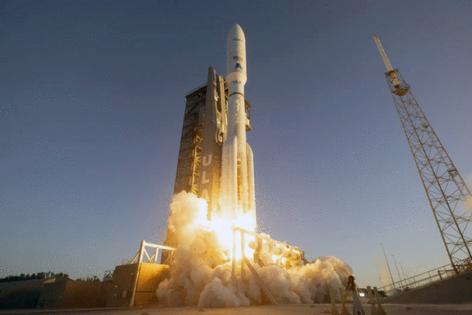ULA manages 2nd launch of year hours after SpaceX's 50th
Published in News & Features
United Launch Alliance took a week to reset, but was able to send up its second launch of the year, another mission for Amazon’s effort to compete with SpaceX’s Starlink internet constellation. The launch came just hours after SpaceX sent up its 50th rocket from the Space Coast this year.
An Atlas V rocket on the Kuiper-2 mission with 27 internet satellites lifted off at 6:54 a.m. from Cape Canaveral Space Force Station’s Space Launch Complex 41.
“Hot, straight, and normal,” said ULA President and CEO Tory Bruno moments after launch on X.
The launch came one week since ULA scrubbed because of bad temperature readings on the rocket related to a gaseous nitrogen purge line.
SpaceX earlier Monday morning launched its 50th mission from the Space Coast, and 76th overall this year including California flights. A Falcon 9 lifted off from Canaveral’s nearby Space Launch Complex 40 at 1:58 a.m. with 27 Starlink satellites. The first-stage booster flew for the 25th time landing on the droneship A Shortfall of Gravitas.
SpaceX has now launched more than 9,000 Starlink satellites since 2019.
The Space Coast has now seen 53 orbital launches for the year, with SpaceX flying all but three. Blue Origin launched its New Glenn rocket for the first time in January while ULA has now managed two missions.
The Atlas V was one of only 14 left in ULA’s stable, seven of which are set aside for Amazon as the company looks to get more than 3,200 of its Project Kuiper satellites into orbit by 2028. ULA’s first launch of the year in April was also for Amazon sending up the constellation’s first 27 operational satellites.
The company also purchased an additional 38 launches on ULA’s new Vulcan rocket as well as missions on Blue Origin, Arianespace and even SpaceX. In total, Amazon has lined up more than 80 flights as it tries to play catchup to SpaceX, which has launched close to 9,000 of its Starlink satellites since 2019.
While the satellites are manufactured in Washington, Amazon has built a $120 million satellite processing facility at a nearly 80-acre site at the Kennedy Space Center’s former Shuttle Landing Facility where they will get the final preparations for launch such as fueling.
For now, ULA is the only company proliferating the constellation, and Vulcan has the lion’s share of contracted missions.
ULA has only flown its Vulcan rocket twice so far, both in 2024, but is expecting to fly it a third time as early as July on a national security mission for the Space Force. ULA President and CEO Tory Bruno said that after that mission, Vulcan would fly its first Project Kuiper flight, one during which Vulcan would have six solid rocket boosters in its most powerful configuration.
After that, Amazon missions will jump back and forth between Vulcan and remaining six contracted Atlas V rockets.
Vulcan rockets have a larger capacity than Atlas V and would be able to carry 45 Project Kuiper satellites per launch. Amazon has a goal of getting more than half of the planned constellation into orbit before July 2026 as part of requirements put forth by its Federal Communications Commission license.
To increase launch cadence, ULA has been building out a second vertical integration facility in Cape Canaveral so it can prepare two rockets for launch at the same time. Its goal is to ramp up to at least two launches per month on the Space Coast. It also has launch capability from California.
ULA had only five launches total in 2024 including the final Delta IV Heavy launch from Space Launch Complex 37. SpaceX under the direction of the Space Force demolished the launch tower at SLC-37 last week in preparation to build out new launch facilities to support its in-development Starship and Super Heavy rockets.
While SpaceX will continue launches from SLC-40 and Kennedy Space Center, ULA will focus its Space Coast operations entirely from SLC-41.
ULA still has seven other Atlas V rockets set aside for other customers. One is for communications company ViaSat and six are assigned to Boeing Starliner launches, so the final flight for Atlas V may not come until as late as 2030.
ULA has a backlog of more than 70 missions including 24 for national security. Its Vulcan rocket was only certified for those launches this spring after years of the delays in the rocket’s development.
Bruno has said ULA would like to ramp up to at least 24 launches per year by the end of 2026.
The company formed as a partnership between Boeing and Lockheed Martin in 2006 and had been the primary launch provider for national security missions until SpaceX joined the competition. The most missions the company has flown in a single year has been 16 in 2009.
--------------
©2025 Orlando Sentinel. Visit at orlandosentinel.com. Distributed by Tribune Content Agency, LLC.







Comments